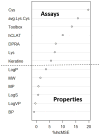Multivariate models for prediction of human skin sensitization hazard
- PMID: 27480324
- PMCID: PMC5243794
- DOI: 10.1002/jat.3366
Multivariate models for prediction of human skin sensitization hazard
Abstract
One of the Interagency Coordinating Committee on the Validation of Alternative Method's (ICCVAM) top priorities is the development and evaluation of non-animal approaches to identify potential skin sensitizers. The complexity of biological events necessary to produce skin sensitization suggests that no single alternative method will replace the currently accepted animal tests. ICCVAM is evaluating an integrated approach to testing and assessment based on the adverse outcome pathway for skin sensitization that uses machine learning approaches to predict human skin sensitization hazard. We combined data from three in chemico or in vitro assays - the direct peptide reactivity assay (DPRA), human cell line activation test (h-CLAT) and KeratinoSens™ assay - six physicochemical properties and an in silico read-across prediction of skin sensitization hazard into 12 variable groups. The variable groups were evaluated using two machine learning approaches, logistic regression and support vector machine, to predict human skin sensitization hazard. Models were trained on 72 substances and tested on an external set of 24 substances. The six models (three logistic regression and three support vector machine) with the highest accuracy (92%) used: (1) DPRA, h-CLAT and read-across; (2) DPRA, h-CLAT, read-across and KeratinoSens; or (3) DPRA, h-CLAT, read-across, KeratinoSens and log P. The models performed better at predicting human skin sensitization hazard than the murine local lymph node assay (accuracy 88%), any of the alternative methods alone (accuracy 63-79%) or test batteries combining data from the individual methods (accuracy 75%). These results suggest that computational methods are promising tools to identify effectively the potential human skin sensitizers without animal testing. Published 2016. This article has been contributed to by US Government employees and their work is in the public domain in the USA.
Keywords: DPRA; KeratinoSens; LLNA; Skin sensitization; allergic contact dermatitis (ACD); h-CLAT; integrated decision strategy; machine learning.
Published 2016. This article has been contributed to by US Government employees and their work is in the public domain in the USA.
Conflict of interest statement
The authors declare that there are no conflicts of interest.
Figures





Similar articles
-
Integrated decision strategies for skin sensitization hazard.J Appl Toxicol. 2016 Sep;36(9):1150-62. doi: 10.1002/jat.3281. Epub 2016 Feb 6. J Appl Toxicol. 2016. PMID: 26851134 Free PMC article.
-
Prediction of skin sensitization potency using machine learning approaches.J Appl Toxicol. 2017 Jul;37(7):792-805. doi: 10.1002/jat.3424. Epub 2017 Jan 10. J Appl Toxicol. 2017. PMID: 28074598 Free PMC article.
-
Non-animal assessment of skin sensitization hazard: Is an integrated testing strategy needed, and if so what should be integrated?J Appl Toxicol. 2018 Jan;38(1):41-50. doi: 10.1002/jat.3479. Epub 2017 May 24. J Appl Toxicol. 2018. PMID: 28543848 Review.
-
Application of Spectro-DPRA, KeratinoSens™ and h-CLAT to estimation of the skin sensitization potential of cosmetics ingredients.J Appl Toxicol. 2020 Feb;40(2):300-312. doi: 10.1002/jat.3904. Epub 2019 Nov 3. J Appl Toxicol. 2020. PMID: 31680285
-
Non-animal methods to predict skin sensitization (I): the Cosmetics Europe database<sup/>Crit Rev Toxicol. 2018 May;48(5):344-358. doi: 10.1080/10408444.2018.1429385. Epub 2018 Feb 23. Crit Rev Toxicol. 2018. PMID: 29474128 Review.
Cited by
-
The Photoinitiator Lithium Phenyl (2,4,6-Trimethylbenzoyl) Phosphinate with Exposure to 405 nm Light Is Cytotoxic to Mammalian Cells but Not Mutagenic in Bacterial Reverse Mutation Assays.Polymers (Basel). 2020 Jul 3;12(7):1489. doi: 10.3390/polym12071489. Polymers (Basel). 2020. PMID: 32635323 Free PMC article.
-
In silico Prediction of Skin Sensitization: Quo vadis?Front Pharmacol. 2021 May 4;12:655771. doi: 10.3389/fphar.2021.655771. eCollection 2021. Front Pharmacol. 2021. PMID: 34017255 Free PMC article. Review.
-
Amino Chemoassay Profiling of Aromatic Aldehydes-Unraveling Drivers of Their Skin Sensitization Potency.Chem Res Toxicol. 2023 Jul 17;36(7):1055-1070. doi: 10.1021/acs.chemrestox.3c00013. Epub 2023 Jun 14. Chem Res Toxicol. 2023. PMID: 37315223 Free PMC article.
-
Artificial Intelligence Applications in Dermatology: Where Do We Stand?Front Med (Lausanne). 2020 Mar 31;7:100. doi: 10.3389/fmed.2020.00100. eCollection 2020. Front Med (Lausanne). 2020. PMID: 32296706 Free PMC article. Review.
-
Titanium salts tested in reconstructed human skin with integrated MUTZ-3-derived Langerhans cells show an irritant rather than a sensitizing potential.Contact Dermatitis. 2020 Nov;83(5):337-346. doi: 10.1111/cod.13666. Epub 2020 Aug 6. Contact Dermatitis. 2020. PMID: 32677096 Free PMC article.
References
-
- 29 CFR 1910.1200. Title 29- Labor. OSHA; Washington DC: 2012. Occupational Safety and Health Standards.
-
- 40 CFR 158.500. Title 40- Protection of Environment. EPA; Washington DC: 2012a. Toxicology Data Requirement Table.
-
- 40 CFR 161.340. Title 40- Protection of Environment. EPA; Washington DC: 2012b. Toxicology Data Requirements.
-
- Allen JE. Drug-induced photosensitivity. Clin Pharm. 1993;12:580–587. - PubMed
Publication types
MeSH terms
Substances
Grants and funding
LinkOut - more resources
Full Text Sources
Other Literature Sources

